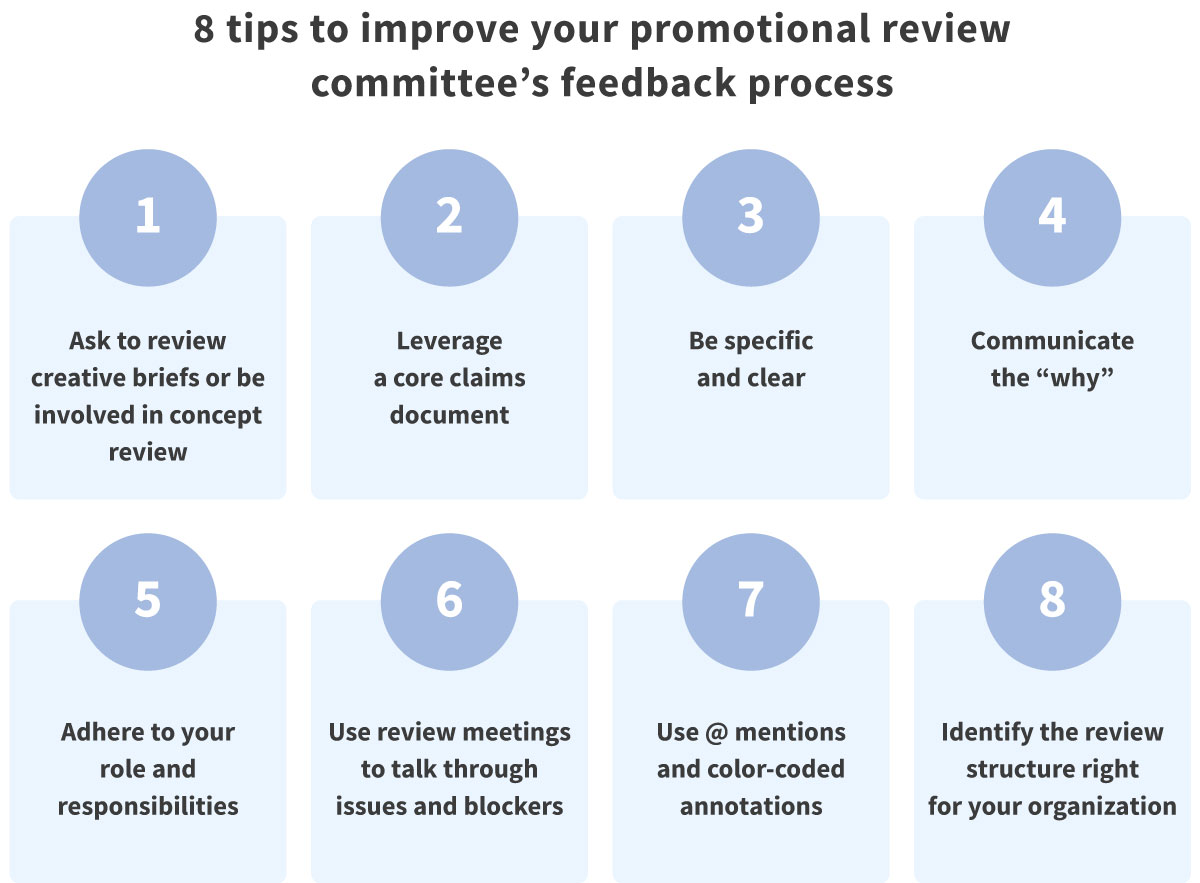Ask to review creative briefs or be involved in concept review
Reviewing creative briefs and being involved in their development is a great way to encourage feedback from everybody on the promotional review committee and creates an opportunity to be a part of the feedback process. Concept reviews allow people to ask questions, share their opinion, and build a consensus before work is started.
Collaborating on creative briefs helps improve the MLR review feedback process since everyone is already familiar with the content and their initial questions are addressed beforehand. With consensus already built, regulatory teams can focus on content compliance such as claims substantiation and verbiage usage.
Leverage a core claims document
For regulatory reviewers, verifying the validity of claims being used in an ad/promo document can be time consuming. If a core claim is used incorrectly, this can cause big rework for marketing teams or agencies. Leverage a core claims document to make regulatory feedback easier by routing and approving all core claims used across promotional materials for review. That way, the entire promotional review committee can approve claims ahead of any other content creation–which simplifies the feedback process, ensures consistency, and helps maintain compliance.
Be specific and clear
Make sure that when you’re giving feedback, you are specific and clear in your direction. What is the exact change that needs to be made? Is the change suggested or required? Does this need additional input from someone else on the ad/promo review team?
Being specific will ensure the appropriate changes are made with fewer rounds of edits. Clarity ensures that none of the feedback is vague or ambiguous.
Communicate the “why”
Oftentimes, the meaning behind a piece of feedback is just as important as the feedback itself. When you give the reasons behind a piece of feedback, your promotional review committee understands the root issues a revision is correcting. Having conversations around why specific feedback was provided can also help you identify areas for improvement and where you need to focus additional training efforts.
Adhere to your role and responsibilities
Everyone on the promotional review committee has a specific expertise relating to their role in the MLR review process. As such, trust your teammates to give appropriate feedback within those defined jobs. If there are not clearly defined roles and responsibilities, consider creating standard operating procedures (SOPs) so that everyone knows what they are responsible for during MLR review.
Use review meetings to talk through issues and blockers
Having review meetings allows your promotional review committee to talk through outstanding issues that arise and blockers potentially holding up a project. These meetings can facilitate discussion, clarify feedback, and help the team actively move forward with the review process.
If you keep noticing the same regulatory feedback during the review cycle, it may be an indication that training is needed to get everyone back up to speed on the review and feedback process. Consider adding short incremental training sessions to these review meetings to keep everyone refreshed on processes and up to date on best practices.
Use @ mentions and color-coded annotations
Purpose built MLR review software solutions provide your promotional review committee with features that help make the feedback and revision process more efficient. Features like an @ mention are incredibly useful for asking questions to or seeking feedback from a specific team member. Create a feedback system by using color-coded annotations for different departments or feedback priority (i.e. urgent vs. non-urgent).
Identify the review structure right for your organization
The structure of your promotional review process is also an important factor to the feedback process.
Using a parallel review structure means that all departments involved in the MLR review process give their feedback simultaneously and synchronously. Parallel review enables you to collect all feedback at once to understand what needs revisions after one review cycle. Plus it allows all departments to see other comments, annotations, and questions. From there, the promotional review committee can discuss and respond to specific pieces of feedback.
A sequential review structure gives each department the opportunity to give revisions one by one in steps. As each department finishes their review, all other departments are able to weigh in on a new “clean” document that has updates included. Sequential review allows for a highly focused review process where each department can give feedback before moving on.
There are benefits to both parallel and sequential review structures. Your current processes will help inform which review structure makes the most sense for your organization and its current workflows.
Ensure that your promotional review committee is running full steam ahead by incorporating these feedback best practices into the processes you’ve already got in place. Remember, great feedback means a more efficient process, and better collaboration throughout your organization.
If you’re looking for additional resources on feedback and process improvement, our ebook on collaboration and process best practices for MLR teams is loaded with tips and tricks to help you continue to optimize your MLR review process.



